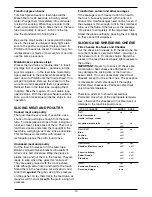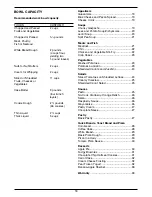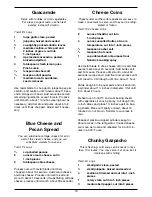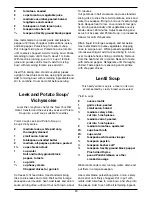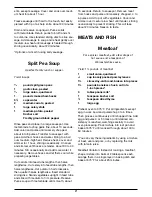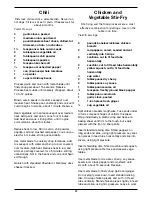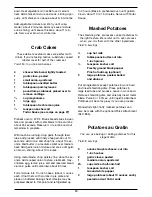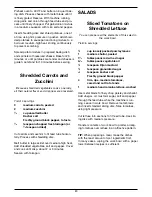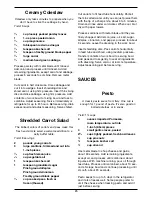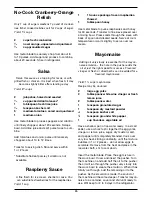
11
hard, lumpy or uneven, continue processing until
it feels uniformly soft and pliable. Make sure that
the blade is firmly pressed back into place after
removing the dough to test it.
Kneading typical sweet dough
Process dough for at least 30 seconds after all
the ingredients are incorporated. It will not clean
the inside of the work bowl. If necessary, scrape
the bowl and process for 5 more seconds.
Adding other ingredients
Cheese, nuts and raisins may be added with the
dry ingredients or during the final kneading. To
leave them almost whole, add them through the
feed tube 5 seconds before you stop kneading.
For a finer texture, add them with the dry ingre-
dients.
Rising
Put the dough in a large, lightly floured plastic
food storage bag. Squeeze out all the air and
close the bag, allowing space for the dough to
rise. Or put the ball of dough in a large bowl coat-
ed with soft butter or vegetable oil. Roll the dough
around to coat its entire surface. Cover it with a
damp towel or a piece of oiled plastic wrap.
Allow to rise in a warm, draft-free place — about
80°F. The rising time is usually about 1½
hours,
but will vary from 45 minutes to several hours,
depending on the type of flour and the humidity
of the air. To test if the dough has risen sufficient-
ly, press your finger in it. An indentation should
remain. If it doesn’t, let the dough rise more and
test again. When it has risen enough, punch the
dough down. It is now ready to shape.
Shaping, finishing and baking
If you shape the dough in loaf pans, coat them
with vegetable oil cooking spray and fill them only
half full. Allow to rise until dough is just slightly
above the top of the pan. If shaping free-form
loaves, let them rise on an oiled baking sheet until
at least doubled in bulk.
Making consecutive batches
You can make several batches of bread dough
in a row. The motor in the Pro Custom 11
™
Food
Processor is extremely efficient. Follow the recipe
for White Bread, page 29.
TROUBLESHOOTING YEAST DOUGH
Blade doesn’t incorporate ingredients
Always start processor before adding liquid. Add
liquid in a slow, steady stream, only as fast as
dry ingredients absorb it. If you hear liquid slosh-
ing, stop adding it, but do not turn off machine.
Instead, wait until ingredients in work bowl have
mixed, then add remaining liquid slowly. Pour
liquid onto dough as it passes under feed tube;
do not pour liquid directly onto bottom of work
bowl.
Butter or margarine, if not melted, must be cut
into tablespoon-size pieces before being added to
work bowl.
Blade rises in work bowl
Blade may not have been pushed down as far
as it will go before processing started. Machine
may be overloaded. Stop it, carefully remove half
the dough and process in 2 batches. Excessively
sticky dough can cause blade to rise even
though it cleans inside of work bowl. If dough
feels very sticky, reinsert blade and immediately
add 2 tablespoons flour through feed tube while
machine is running.
Dough doesn’t clean inside of work bowl
• Amount of dough may exceed maximum capac-
ity of your food processor. Remove half and
process in 2 batches. See page 18 for machine
capacity.
• Dough may be too dry. If it feels crumbly, add
water – 1 tablespoon at a time – while machine
is running, until dough becomes moist and
cleans inside of work bowl. Wait 10 seconds
between additions of water.
• Dough may be too wet. While machine is run-
ning, add 1 tablespoon of flour. If necessary,
add more – 1 tablespoon at a time – until dough
cleans inside of work bowl and forms a ball.
Nub of dough forms on top of blade and does
not become uniformly kneaded
Stop machine, carefully remove dough, divide it
into 3 pieces and redistribute them evenly in work
bowl. Make sure that blade is firmly pressed back
into place after removing the dough. Continue pro-
cessing until dough is uniformly soft and pliable.
Dough feels tough after kneading
Divide dough into 2 or 3 pieces and redistribute
evenly in bowl. Process 10 seconds or until uni-
formly soft and pliable.
Summary of Contents for PRO CUSTOM 11 DLC-8S
Page 17: ...17 NOTES ...
Page 35: ...35 NOTES ...














